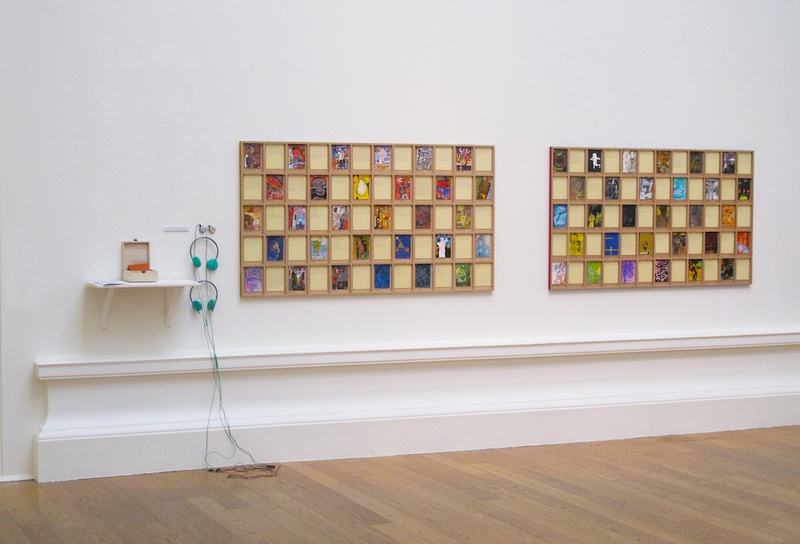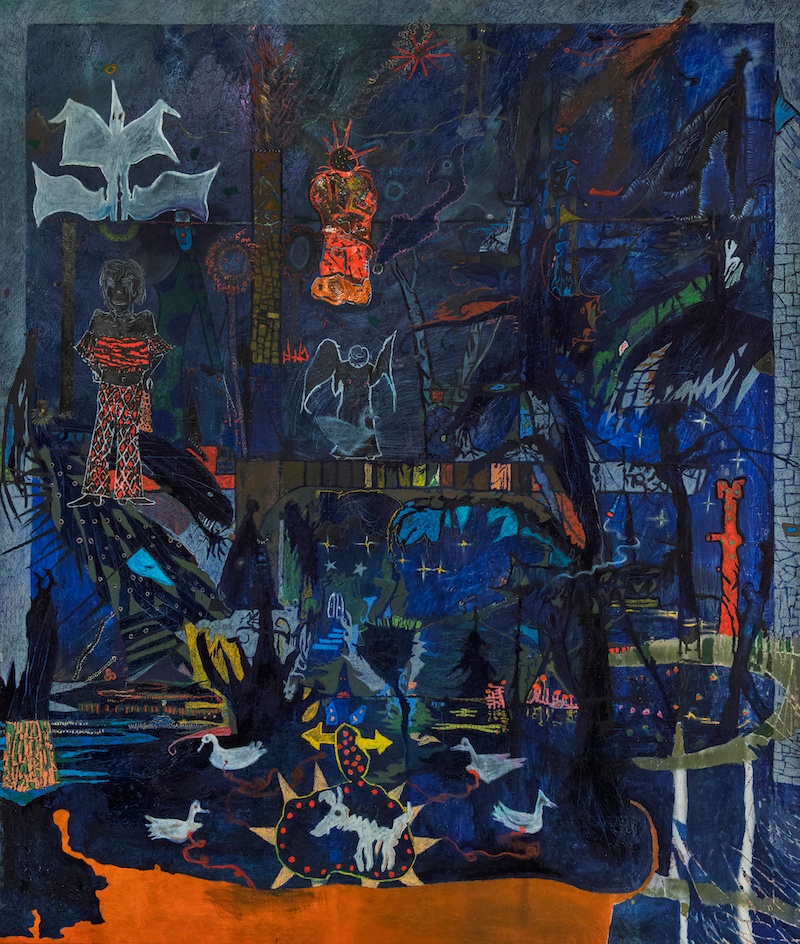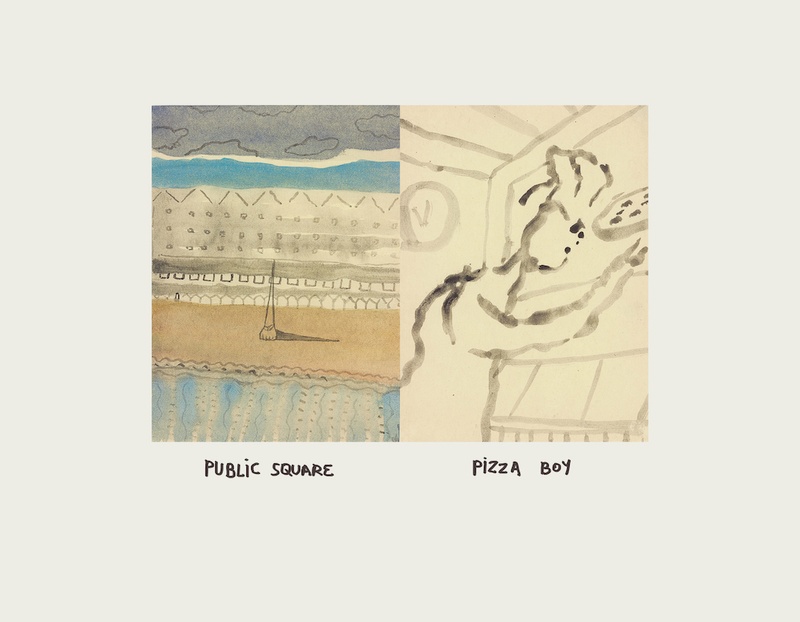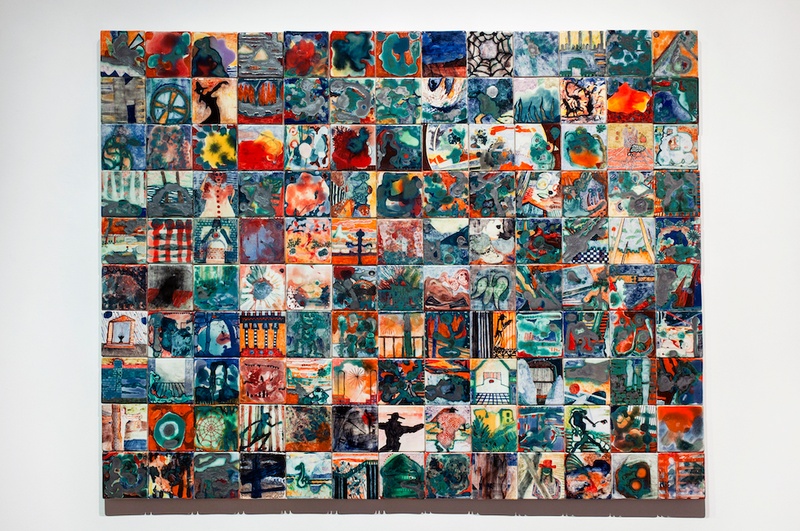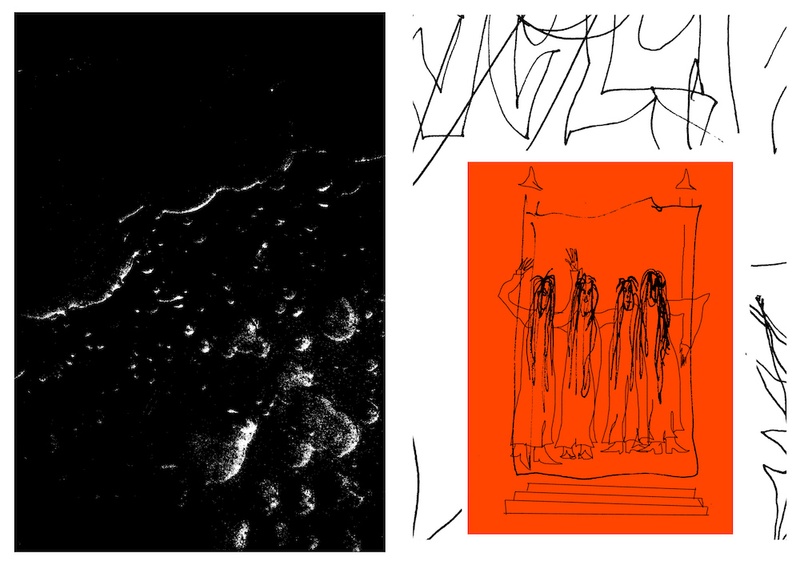I feel like you create universes with your exhibitions. Do you know what kind of worlds you want to create before you begin?
I find that the more I try to keep things grounded or tied to something super specific early on, the harder it is to get in the zone and it stiffens the creative process. The vaguer and more open-ended the idea I have in the beginning is, and the more I tune out while I’m painting, the better everything turns out. Connecting dots and making associations between the paintings, drawings etc. takes place later, when I start looking at the work that I’ve already made as a viewer. Going through and discovering the references hiding in the paintings etc., is a very fun self-exploratory/detective work process that eventually ties everything together. Nothing is ever pre-planned, it just slowly unravels.
Can you further describe that self-exploration?
Yeah, definitely. I can give you a few examples. So, my first big project was called Interzoned and is the most fragmented narrative and the most dense universe I have created as an artist. It was a drawing installation consisting of little drawings I had made in notebooks with accompanying texts: poetry, short stories, jokes and little observations. I had been working on the drawings for a long time and then in a very short time I made notes on them, like the first things that popped in my head when I was looking at them and all these ideas started coming. So, within a few weeks I wrote something inspired by each one. The result was a hybrid mixture of references that shaped a loose narrative from one picture to the other—very associative. It wasn’t so much a story but a universe, where all these things coexisted as part of my personal mythology and now they were out in the open.
Interzoned Installation; drawings, text and audioguide in collaboration with Benjha (Other People), 2013.
Then I tied it all together with a soundtrack I made with my friend Benjha, who is a music producer. That was the first thing that we did together and it was such an eye opening process of sending stuff back and forth. He would send me pieces of music and I would record the texts as narration over the music. We ended up with a soundtrack/audioguide that really enhanced the experience of the drawings and animated the writings. My next project was Two Johns, a duo show with Antonakis Christodoulou about a film not yet made, a sort of gothic “buddy movie through the ages.” For that, I made a lot of drawings which is kinda my go-to move as an artist. While I was doing that I was also making a lot of notes, which I uploaded on a tumblr Antonakis and I had started to exchange ideas.
So the process was very exploratory?
Yes. If Antonakis and I were discussing certain characters of the Two Johns universe we would send each other songs saying things like: “Oh this character would probably listen to this type of music, hang out in this certain place,” like little details that progressively made the characters more real to us.
Would you always show each other everything you made immediately?
Not always. After a few months we had ended up with a lot of artwork, paintings and weird photographs that we had collected from flea markets. So, we had all this material to work with that inspired us and felt like it could be part of this whole universe. Then, I started writing texts with a different approach than in my previous projects because there was a set of parameters.
We already had the title and the character dynamics and maybe also the style, because we were playing around with a lot of the classic vampire themes and stuff and trying to add to that. Antonakis and I share a strong love for teenage sitcoms and vampire films and were very conscious about building on that for our show and adding a gothic twist to it. Antonakis was also writing for his pieces so we would bounce off each other, insert personal jokes and references.
There is this high singing in the air (title after Kenneth Patchen’s poem At The New Year), mixed media painting (180x150cm), 2020.
So you were responding to your own work by writing as well as responding to each other’s work.
Yeah, it was very alive and very fun. Then, we also made a soundtrack with Irene Lyssari and Benjha. We kind of had a Twin Peaks fantasy. I couldn’t imagine the show without music just like half the magic of Twin Peaks lies in its soundtrack.
Definitely. The intro is the best.
Exactly. It’s almost hypnotic, it puts you into the right mood and headspace to watch the show. I thought it was super important for the viewer to go through an “indoctrination” when they entered the gallery and to be able to tune into our universe immediately, without me having to hold their hand and explain stuff to them. You walk into the gallery, the soundtrack is already playing. Immediately you tune out of your previous state.
There is another interesting point that maybe arrives from that: I’ve always been a huge fan of cinema and television. I’ve always had the belief that some of the narrative techniques in cinema can be very successfully applied to a painting or an art exhibition. Most people upon entering an exhibition will only spend a few seconds looking at a painting that someone spent a lot of time making. Unless the piece really resonates with them they won’t return to look at it. I wanted to force people, in a subtle way, to experience paintings in the same way they would a film, in the sense of pulling them in. Have them submerge themselves in it.
Other than the soundtrack, what other cinematic techniques do you use for your exhibitions?
The way editing works in a movie, cutting from one image to another, when it is good cinema, is the essence of image association. I always have this in mind when I assemble my exhibition—how do you build up a rhythm from piece to piece whether it is a painting next to another painting, a sculpture and a painting, or whatever. I am always striving to build a sense of rhythm.
Then I look to cinema for “big picture” narration stuff but not just cinema but also something like the cut-up technique by Burroughs or Tarkovsky’s “Interzone concept.” I’ve always found the question of “how to present a story that the other person can feel without it being linear’ very fascinating. That is something David Lynch is very successful at. I think it makes total sense that Lynch started off as and is a painter.
Take for example two very different films of his, Straight Story, arguably his most linear and accessible film and Mulholland Drive, probably his most complex, dense and confusing film. Both share similar fascinations at their core; it’s just a different way of giving out the story. They both obsess about America and all the mythology around America and both have a sense of voyeurism. Mulholland Drive takes place in a large city but is very claustrophobic and Straight Story is a road movie tumbling along small towns. One has a fearful gaze and the other is full of wonder, beauty and hope. However, they both present a large cast of characters that appear briefly but do not feel like fragments. They feel whole and very real and you can feel their aura beyond the screen. By being introduced to them, a world slowly takes shape.
I make sure to make mental notes when I’m reading or watching something that makes an impression on me. When I’m in my studio these mental notes, almost unconsciously, inform how I operate.
Public Square/Pizza Boy, watercolor and ink diptych from the Key to the Kuffs exhibition, 2017.
Do you feel like a storyteller?
I definitely feel like a storyteller but I sometimes feel as if I make stories by accident. I never know what stories I am about to tell. But I don’t care. It is something that happens and it’s a combination of being hyper-conscious while you’re doing it and also completely absent. I can’t explain it any other way.
You are starting a publishing house for artists books and limited edition records called Hideout Editions. How will your way of creating worlds flow into publishing?
I have been toying with the idea of a publishing house for a long time. It’s also a dream I inherited from my mother. She worked as a book editor and translator of a lot of famous children’s books mainly from French to Greek. As a child I was very lucky to have access to a lot of cool books. It was probably what got me passionate about art and drawing.
I still have a very soft spot for children’s books. To me, artist books, in my opinion, are an extension of children’s books. It might sound a bit silly as a theory but I think they operate on a similar level. Both artists’ and children’s books often operate on a very abstract level, have different layers of meaning and can hit different notes of your subconscious in a very impactful way while being playful. A good book that you read as a child can really help you develop a sense of mythology and imagination. I still find traces and things from books that I read as a child in my work now.
So basically, long story short, I always wanted to start a publishing house because I have always been making books and at some point I was like, “Okay, I can’t be bothered pitching my book ideas to people or trying to find the right place to publish my book.” That’s pretty much a whole other job.
And also you see publishing potential in other people’s work.
Yes, I meet people, see their work and begin curating things in my head and make their work part of a larger universe of stuff. I don’t know. I think we’re one of the first generations to grow up with such a plethora of culture readily available to us. We are the first generation that had access to streaming things online and downloading music illegally from the Internet.
Napster…
I think this reality has led to some people having really interesting associative minds. A book is a very interesting format to explore this. Books are like little worlds. I remember when I was younger, I would read skateboard magazines before bed, or artist books, fanzines and things like that, anything that had to do with punk music. All that stuff inspired me profoundly and helped me escape the routine of a long school day. It was also a way of seeing different outlooks and that really fed into my natural sense of curiosity. It was and is fascinating. For me it was also the best cure for depression. We live in such a globalized world with horrors taking place everywhere. Because of the access of information we have, you constantly see bad things happen everywhere whether it is next door to you or on the other side of the planet. It’s nice to connect with people on something more positive and connect with a good part of humanity. You know what I mean? It sounds almost naïve saying that.
Dice of Life, installation of painted and glazed ceramic tiles (130x100cm), 2018.
No, I know what you mean. I think the type of books you speak of, invite us to connect with the author’s inner child and that is connecting to something innocent but it’s not naïvety.
No, exactly. Actually, that’s a really interesting thing that you said. The difference between naïvety and innocence is a huge thing to me as well. It’s one of the main things I have been thinking about the last few years. Actually, that’s the theme of the first book that I made for the publishing house: how do you try to preserve your innocence while you grow up? In the beginning, it was supposed to be about the concept of hell as a coming of age thing told through heavy metal and punk and other subcultures. Then, I realized, while making the book, that it is not about hell on earth or the hell you carry inside you but it is more about the innocence that you have. I would translate that innocence into that certain spark every person has within them. When your sense of wonder towards the world fades, that’s when you’ve lost your innocence.
I think maintaining the spark and finding ways to feed it is almost like an art form in itself. Staying curious and grateful. Maybe growing-up is the process of taking things for granted.
Yeah, that is an accurate definition.
You’ve mentioned that writing is a part of your “making sense” process once you’ve painted in a “stream-of-consciousness” kind of way. How do you bring painting and writing together?
The tricky part is to find a way that my writing can add to the paintings, how to avoid being descriptive or explanatory. I take painting very seriously and I love paintings for the things that only paintings are able to do.
When I use words, I am very careful to make sure the paintings don’t end up becoming illustrations to what I’ve written. This would be very problematic as I see myself firstly as a painter. It would take away the power of the paintings. A very critical moment for me and my relationship to writing came after the show Two Johns. The show was called Key to the Kuffs and I decided just to title my pieces and not add any other writing. It was a series of diptych water color paintings. My goal with the titles was to open things up to the viewer while keeping the paintings a mystery. It was tricky.
Book spread from Warrior artist book (screen printing and riso, edition of 36, produced during a residency at the Frans Masereel Centrum in Belgium), 2020.
The titles were so epic. I remember them clearly.
I feel like the most I’ve ever expressed with words was via these titles. I feel like the writing for my previous shows still holds up, but managing to say a lot with less and fusing painting and writing in that way was an important step for me. It was almost like the process of reducing your painting to the bare essentials. That’s what I tried to do with the titles. I reduced the writing more and more until I got the right feeling from each title.
One good example was this diptych that showed a beach landscape and it was called Black Metal Beach and right next to it was this almost abstract painting that showed some flowers and stuff. It was almost abstracted to the point you couldn’t exactly understand what you were looking at and it was inspired from that movie Honey I Shrunk the Kids. There is a point in the film where the children are miniature size and try to cross through their suburban backyard, which has in turn transformed into a wild jungle. Pairing these two images in combination of the titles was the biggest homage to the things that inspire me like American suburbia. It created a coming-of-age movie aspect to the paintings. Black Metal Beach represented the archetypal hangout spot where teens do forbidden stuff away from the gaze of their parents. A secret hang out, like out of Goonies or The Little Rascals or any kids’ film from that era.
David Samperthai Recommends:
Bacurau (2019), film written and directed by Kleber Mendonça Filho and Juliano Dornelles. I used to have dreams like this film, so glad it exists.
Happy As Lazzaro (2018), film written and directed by Alice Rohrwacher. My girlfriend recommended it; we watch it and it blew our minds.
Billy The Kid (2007), film by Jennifer Venditti. I love anything coming of age related and this is on top of the list…so magical!
This Young Monster, book by Charlie Fox (Fitzcarraldo Editions). I wish more writing on the arts was as personal, passionate, and associative as Charlie’s.
Any music by Zelooperz. This guy feels too much. Such expressive diverse music.
This content originally appeared on The Creative Independent and was authored by Grashina Gabelmann.
Grashina Gabelmann | Radio Free (2022-02-25T08:00:00+00:00) Painter David Sampethai on staying connected to your inner child. Retrieved from https://www.radiofree.org/2022/02/25/painter-david-sampethai-on-staying-connected-to-your-inner-child/
Please log in to upload a file.
There are no updates yet.
Click the Upload button above to add an update.
